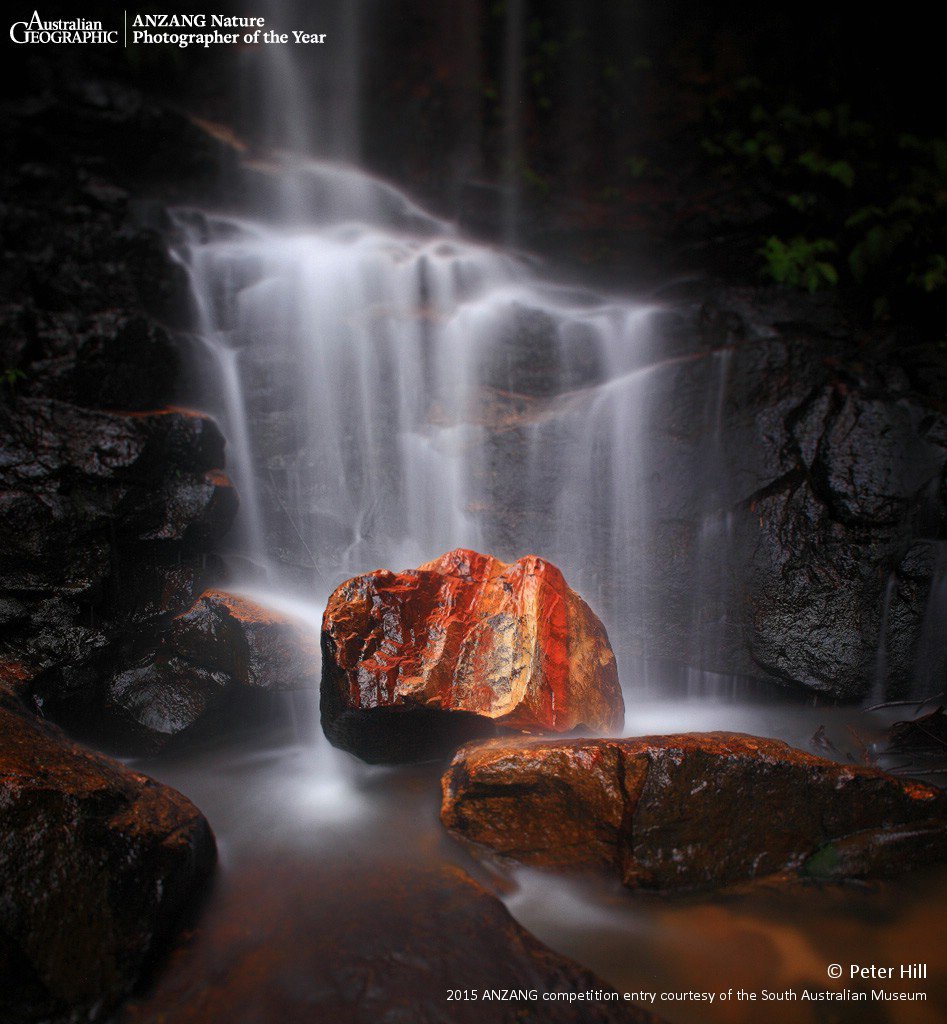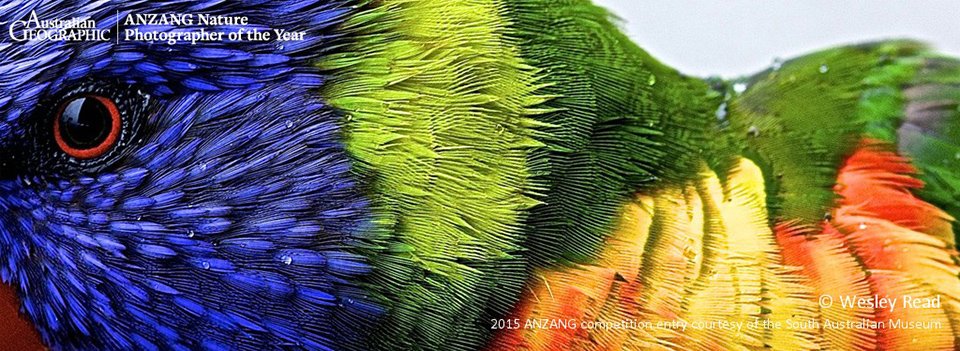ANZANG 2015 photo contest winners

RED JELLYFISH, UNIDENTIFIED SPECIES. Ningaloo Reef, Western Australia. Several weeks after a major rain event in the Exmouth Gulf region there is a bloom of these red jellyfish. Beaches are carpeted with them and underwater they are everywhere. This image was captured during an event that ran for a couple of weeks in autumn 2009. Canon EOS 50D, Tokina 10-17 fisheye at 10mm, 1/250, f11, ISO 200, handheld, 2 x Inon Z240 underwater strobes, Subal C40 underwater housing
Photo Credit: Ross Gudgeon, New South Wales
EASTERN GREY KANGAROO, MACROPUS GIGANTEUS. Icy looks, Cascade Trail, New South Wales. I found this female eastern grey kangaroo high in the Australian backcountry during one of the biggest storms of the season. The snow was so deep her fur was covered in ice. We both sheltered behind the snow gum, understanding that the wind was scarier than either of us. Nikon d800e, Nikon 28-300mm f5.6, 1/500, f/8, ISO 500, 28mm, handheld
Photo Credit: Charles Davis, NSW
SUPERB LYREBIRD, MENURA NOVAEHOLLANDIAE. Lyrebird in the mist. In a heavy mist this superb lyrebird was calling to another that was close-by from the granite boulders that crown the top of Mount Ellery in East Gippsland. East Gippsland, Victoria. Canon EOS 5D Mk III, Canon zoom lens EF 24 – 105mm, 1/800, f/6.3, ISO 1600, handheld, focal length 98mm
Photo Credit: Judith Deland, ACT
RED-SPOT NIGHT OCTOPUS, OCTOPUS DIERYTHRAEUS.Hunting night octopus. On a night snorkel in the Whitsundays, I witnessed a range of cephalopods taking advantage of the cover of darkness, such as this red-spot night octopus. This particular individual was hovering above the reef trying to catch shrimp using a range of amazing hunting displays as seen in this image. Whitsunday Islands, Queensland. Canon s95 (with FIX underwater housing), UWL04 fisheye wet lens, 1/160, f/5.6, ISO 160, 2 x Sea&Sea YSD1 strobes, handheld
Photo Credit: Johnny Gaskell, VIC
MANTA RAY, MANTA SP. From above you get a true indication of the vast numbers of large marine animals in Ningaloo Reef’s lagoons. I will never forget seeing these huge manta rays swimming so close to shore. Over 30 manta rays, dugongs, humpback whales, tiger sharks and dolphins were seen during this flight. Batemans Bay, Ningaloo Reef, Western Australia Nikon D90, Nikon 18-105 VR, 1/400, f/7.1, ISO 250, handheld
Photo Credit: Johnny Gaskell, VIC
CAMOUFLAGED EEL. MORAY EEL, FAMILY: MURAENIDAE. The Poor Knights Islands Marine Reserve offers some of the best temperate water diving in the world. The kelp-covered reefs provide the shelter for a range of species. This moray eel was barely discernible amongst the kelp – the perfect cover for an ambush predator. Poor Knights Islands, New Zealand. Nikon D800, Nikon 10.5mm, 1/250, f/10, ISO 400, Ikelite housing, twin DS161 strobes, handheld
Photo Credit: Justin Gilligan, NSW
ANTARCTIC BEECH, NOTHOFAGUS MOOREI. New England National Park was registered as a World Heritage Area in 1986 due to the universal significance of its biological and landscape values. The park’s genetic diversity and natural cycles remain unaltered, which has allowed the survival and evolution of rainforest species over geological time. New England National Park, New South Wales. Canon 5D Mk II, Canon EF17-40 f/4L USM, 1/5, f/11, ISO 500, tripod, circular polarised filter
Photo Credit: Drew Hopper, NSW
SARGASSUM SEAWEED, SARGASSUM SP. I love bold primary colours and strong shapes in my photography. I like the way this common sargassum seaweed glows a beautiful golden colour in my underwater lights against the bold rugged shape and texture of the rocks. To me this image is all about the shapes, tones and textures. Bushrangers Bay, Shellharbour, New South Wales. Nikon D810, Nikkor 14-24mm F2.8, 1/200, f/18, ISO 400, Inon Z220 Substrobes at ½ power, handheld, Aquatica ND810 for Nikon D810 with homemade 18” Dome Port
Photo Credit: Matthew Smith, NSW
EDITH FALLS. Wedged between Sylvia Falls and Lodore Falls, the smaller Edith Falls presents a great opportunity for close-up study as the track down the valley goes directly in front of its face. This was shot early one morning in foggy conditions, well before the sunlight reached over clifftops and into the valley. Valley of the Waters, Blue Mountains National Park, New South Wales. Canon EOS 5D Mk II, Canon TS-E 24mm f3.4L, 20, f/8, ISO 125, Hoya ND x400 Filter, Manfrotto 055XPROB tripod with 496RC2 Ball Head
Photo Credit: Peter Hill, NSW
ROLLING THUNDER. There had been a big storm off the coast and the seas were enormous. The salt spray was thick in the air and the sound of breaking waves filled my ears. I stood and watched in awe of the power of the ocean. Denhams Beach, New South Wales. Nikon d800e, Tamron 70-300mm, 1/30, f/18, ISO 50, RAW, tripod
Photo Credit: Andrew Carter, NSW
DEVIL’S PUNCHBOWL.The Devil’s Punchbowl is located where the southern alps divide the west and east coast of New Zealand’s South Island. It receives over one metre of precipitation a year. Arthur’s Pass, South Island, New Zealand. Nikon d750, Nikon 24-70mm f/2.8, 1/250, f/2.8, ISO 250, UV filter, Gitzo mountaineer tripod with a Really Right Stuff ball head
Photo Credit: Doug Gimesy, VIC
EUCALYPT DAWN. Early sunlight is streaming across the eucalypt forest creating a scene full of contrast when a surface inversion traps cloud at ground level in the valley. This meteorological event occurs when there is radiation cooling of the ground and the air immediately above it after a clear and dry night. Megalong Valley, Blue Mountains, New South Wales. Canon EOS 5D Mk III, Canon EF70-200mm f/4L IS USM lens, 1/400, f/5.6, ISO 160, handheld
Photo Credit: Andrew Peacock, QLD
GREY HEADED FLYING FOX, PTEROPUS POLIOCEPHALUS. Bat blur. A single grey-headed flying fox captured in two stages of flight using a combination of slow shutter speed, ambient light and rear curtain flash. The darker ghostly silhouette was captured with the ambient light and slower shutter speed then the flash fires capturing a second impression of the bat. Balgowlah, Sydney NSW. Canon 5D Mk ll, EF 100-400mm f/4.5-5.6 IS USM, 1/5, f/14, ISO 400, Canon 580ex flash fired in Rear Curtain Sync mode, handheld
Photo Credit: Marc Lynch, NSW
NEW MOON. Pursuing nature photographs has taken me all over the world, but I am increasingly of the opinion that it is more ecologically responsible to confine one’s focus to the local. This shot of the new moon was created from the comfort of a rocking chair on my verandah. Pomona, Queensland. Canon 5D II, 100-400mm, 8, f/11, ISO 400, handheld
Photo Credit: Raoul Slater, QLD
CAT, FELIS CATUS. Perfect predator. This aggressive male cat was one of 140 trapped to help reduce impacts on the endangered red-tailed phascogale, a small carnivorous marsupial that has suffered an estimated 99 per cent reduction in its distribution since European settlement. Feral cats and foxes are now among the main threats to this unique species. Harrismith, Western Australia. Canon EOS 40D, Sigma 17-35 2.8DG (set at 17mm), 1/250, f/8, ISO 125, 550ex (evaluative -1) flash, handheld
Photo Credit: Leon Rakai, WA
EARTH, WATER, FIRE, SKY. Although natural in appearance, this scene would not exist without extensive human presence. Advancetown Lake can be seen, created by Hinze Dam. The apparent bushfire is a large burn-off operation in full swing. Finally, light pollution from the Gold Coast colours the night sky. Lower Beechmont, Queensland. Nikon D600, Nikon 24-85mm f3.5-4.5, 16 min 13 sec, f/8, ISO 100, tripod
Photo Credit: Dave Kan, QLD
AUSTRALIAN FAIRY TERN, STERNULA NEREIS NEREIS. Status: Vulnerable. As I lay on the beach, these young fairy terns became so comfortable with my presence that some landed very close to me. Their habit of nesting on the beach makes this beautiful species extremely vulnerable to the activities of 4WD vehicles and predation by feral animals. Woodman Point, Western Australia. Canon EOS-1DX, Canon EF 500mm f/4L IS II USM + Canon EF Extender1.4X, 1/2500, f/5.6 (exposure bias of +1), ISO 1000, handheld
Photo Credit: Georgina Steytler, WA
YELLOW-EYED PENGUIN, MEGADYPTES ANTIPODES. Status: Threatened. The yellow-eyed penguin is one of the world’s rarest penguin species with an estimated population of 4000 individuals. This individual had just come out of the water and started its arduous journey up the steep slope towards its nests when I caught it peeking over a boulder. Otago Peninsula, South Island, New Zealand. Canon 50D, Canon EF 300mm f/4L IS USM, 1/500, f/5.6, ISO 250, handheld
Photo Credit: Johan Larson, QLD
WATERFALL. Captured in this image is the stunning detail of light flickering through falling water, a minute phenomenon that normally would go unnoticed. Fitzroy Falls, New South Wales. Nikon D3200, 18-105mm f/3.5-5.6, 1/10, f/22, ISO 100, tripod
Photo Credit: Ryan North, NSW, aged 16
RAINBOW LORIKEET, TRICHOGLOSSUS MOLUCCANUS. The rainbow lorikeet is a loud and colourful bird found along eastern Australia. On the morning this was taken it had been raining and several pairs were taking shelter on my grandparent’s veranda, where they occasionally feed the birds. This allowed me to sneak up on them and get my shot. Lake Cathie, New South Wales. Canon EOS 70D, Canon EF 100mm f/2.8 macro, 1/160, f/5.6, ISO 320, handheld
Photo Credit: Wesley Read, NSW, aged 15
FEATHERED SYMMETRY. Watching this White-winged tern (Chlidonias leucopterus) amongst a little tern colony when it stretched its wings ready for take-off. I simply cropped the image fairly tightly to focus on the wonderful symmetry and graphic simplicity of the feather structure against the blue of the lake. Lake Wollumboola, New South Wales. Canon EOS-1DX, EF 500mm f4L IS + 1.4X extender, 1/3200 @ f8, ISO 640, Mongoose tripod head on Skimmer Ground Pod
Photo Credit: David Stowe, NSW
INQUISITIVE PIGFISH. RED PIGFISH BODIANUS UNIMACULATUS. Probably one of New Zealand’s most charismatic fish, the red pigfish provides stark contrast the kelp-covered reefs of the Poor Knights Islands Marine Reserve. During my visit, this species was high on my shot list, so you can imagine my surprise when this individual took a liking to its reflection in my camera housing dome port. Poor Knights Islands, New Zealand. Nikon D800, Nikon 16-35mm, 1/15, f16, ISO64, Ikelite housing & twin DS161 strobes, handheld
Photo Credit: Justin Gilligan, NSW
LOW LIGHT CONFUSION. BLUE MAOMAO SCORPIS VIOLACEA. The Poor Knights Island have been hollowed and shaped by the ocean into a web of caves, tunnels and cliffs. Rikoriko Cave is currently considered the largest sea cave in the world. In the perpetually dark environment, deep water species can be found in the shallow water, amongst shimmering schools of Blue MaoMao that confuse predators through their advantage of sheer numbers, and lone snapper lurk in wait for an easy fish meal. Rikoriko Cave, Poor Knights Islands, New Zealand. Nikon D800, Nikon 10.5mm, 1/13, f8, ISO400, Ikelite housing & twin DS161 strobes, handheld
Photo Credit: Justin Gilligan, NSW
JELLYFISH SUNSET. UNIDENTIFIED SPECIES. Jellyfish are amongst my favourite photographic subjects, because they are so unusual, they seem to originate from another planet. Surfacing from a dive late one afternoon, I found this individual pulsating through the shallows beneath the perfect orange glow of the setting sun – the perfect vision to end the day! South Coast, New South Wales, Australia. Nikon D800, Nikon 10.5mm, 1/40, f14, ISO100, Ikelite housing & twin DS161 strobes, handheld
Photo Credit: Justin Gilligan, NSW
Saltwater Crocodile.
Photo Credit: Justin Gilligan, NSW
BLUE WATER VIEW. GREEN TURTLE CHELONIA MYDAS. Bunaken National Park is located in the heart of the coral triangle. Colourful brigades of tropical fish swarm along vertical reef walls covered with a coral veneer home to hidden secrets such as frogfish and pygmy seahorses. The walls are also home to green sea turtles that arrive here from the open ocean to rest on perfectly formed ledges with the ultimate blue water view. Bunaken, Sulawesi, Indonesia. Nikon D300, Nikon 10.5mm, 1/125, f9, ISO200, Ikelite housing, twin DS161 strobes, handheld
Photo Credit: Justin Gilligan, NSW

